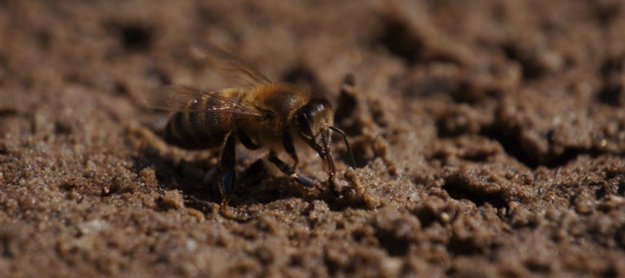How do we solve the bee problem? Do you even really know what causes it? Let's find out and see what we can do to help the cause.
—This post is courtesy of Honey Colony. (Original publish date December 26, 2015), Shared with permission—

Bee Problem And Beyond
We often hear about pollinator declines, but the issue is much bigger than just a bee problem. Our planet faces numerous large scale and inter-related problems, including climate change, large-scale land use change, invasive species, pollution, and human health problems. Alarmingly, we are currently undergoing widespread and major biodiversity losses across the planet.
Many habitats and groups of plants and animals are undergoing range constrictions, displacements, or complete extinctions in the U.S. and around the world. It is tempting to silo the bee problem, confronting each issue individually. Confront the Varroa; reduce pesticide use; increase bee forage; improve bee resistance to disease.
But if we don’t solve the deeper problem with our food production system, the bees are going to continue to die.
Immortality Alchemy’s Immune System Boost Bundle: The Keys To “Immortality”
Food Production And Land Use
Many of these problems are inherently linked to our food production system. Representing 34 percent of the land surface of our planet, agroecosystems (cropland and rangeland) are the largest biome on planet Earth. Because of the scale, it is arguable that decisions made on these agroecosystems affect nearly every other habitat and species on the planet either directly or indirectly.
But even diversity within agroecosystems is in steep decline. In the U.S., we have experienced major shifts and perturbations to our food production system since 2007; federal ethanol policies have been linked to these perturbations by mandating a market for corn grain-based ethanol.
Soybeans are produced on a similar number of acres as before the Energy Independence and Security Act (EISA) policy took effect, but nearly every other crop is planted on substantially less acreage than it was. What is replacing these crops? Corn has increased in acreage by 14 percent since 2007, and this single plant species is currently planted on five percent of the land surface of our country.
There are consequences to this simplification. Corn, soybeans, and cotton are planted on nine percent of the land surface of our country. Three species where once there were hundreds. And the majority of acres of all three are genetically modified to resist pests. All are treated with herbicides. All are maintained with chemical fertilizers. And nearly all are treated with neonicotinoid seed treatments. These inputs are the only way that these simplified systems can remain productive. We have replaced biodiversity with technology.
I question this paradigm of food production. I question the simplification of our landscapes. I question the unnecessary use of insecticides and GM crops. And I question the use of corn for ethanol. As a result of this, everyone that I care about was attacked either directly or indirectly by my employers with the USDA. Our spirits were crushed. And I was punished for conducting science and publicizing results that questioned this paradigm.
But in my exploration for answers, I have discovered something that is both amazing and gives me a tremendous feeling of hope. I have come to see that nearly every major problem that we face as a society can be reduced or solved entirely through better management of our food production systems.
Conceptually, farm productivity and environmental health can be fostered with two simple concepts. Increase diversity. Reduce disturbance. Disturbance means things like reducing or eliminating tillage and pesticide use. Biodiversity can accomplish many of the things we rely on inputs for in our current paradigm. Fertilizer comes from animals and plant matter. Predators and competition are nature’s insecticides. Herbivores and competition are nature’s herbicides. The importance of plant diversity in and near farmland cannot be overstated.
Food production in nature’s image is not simply in my imagination. There are farmers, ranchers, and beekeepers around the country that are already making money by doing this, and they have become my friends (see a list of links below). Although every region and farm operation differs in its circumstances, there are some key elements to ecologically-based farming that are consistent. Don’t till the soil, or reduce your tillage substantially. Cover the soil with plants all the time. Integrate animals into cropland. Increase perenniality areas near farmland. I don’t need a crystal ball to see the future of farming. I can go to the farms where the future is already happening.
Collapsing The Monoculture-centric Paradigm
But what is alarming is that science often doesn’t support these innovative producers. Quite the opposite. That’s because the farmers on the leading edge of regenerative agriculture are doing things on their farms that science says can’t happen. And when scientists can’t figure out how to produce crops ecologically on their research farms, the scientific data is thrown down as a hurdle that impedes innovation.
Risk Management Agency struggles with ensuring farmers who are trying to innovate agriculture by thinking outside the current paradigm. Farm Service Agency struggles to lend money to operations that are producing new products or old products in new ways, because state averages say that these strategies aren’t profitable under the current paradigm. Much of the infrastructure and science that is going on is intended to support the current monoculture-centric paradigm. But we should be creating is an entirely new one.
We require a transformational shift in food production. And transformational changes do not come from the government and they do not come from large research institutions. Transformation of this nature comes from the bottom up. It comes from the farmers and the beekeepers and the ranchers themselves. And it is happening right now.
To support this incredible innovation, I have a vision for the future. A network of research, education, and demonstration farms across the country. This network would link the top agroecologists in the world with the leading producers in regenerative agriculture to create centers for excellence in biodiverse farming. This network could respond to local needs and circumstances to be as relevant as possible, while upholding the central philosophies and practices of regenerative agriculture. And this network of farms would be also be learning centers where the next generation of students, farmers, and scientists can learn and see the new paradigm in food production. The first of this network is Blue Dasher Farm and we need your help.
We can produce food AND conserve the environment. I have seen it. And I will devote the rest of my life to supporting it. It is the right thing to do and the right time to do it. Heal the soil, and we aren’t going to have a bee problem anymore.
So are you going to join in? Let us know below!

[…] Next: Solving the Bee Problem […]